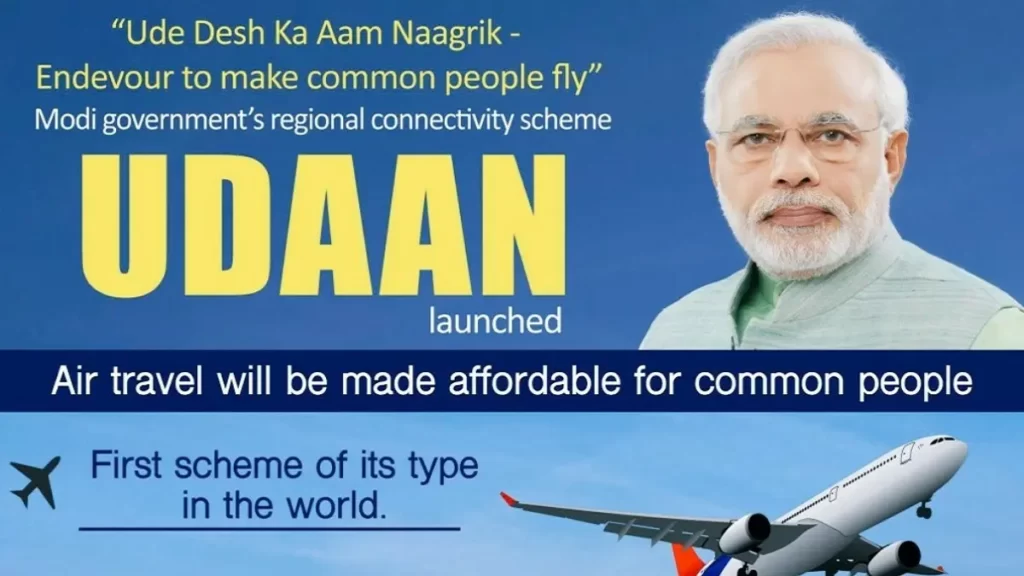Description

Copyright infringement not intended
Context: The UDAN scheme, which aims to provide affordable air connectivity to underserved regions of India, is facing severe challenges. According to a report, more than 50% of the routes awarded under the scheme have been grounded. The report also highlighted the low passenger demand, high operational costs, and inadequate infrastructure as some of the major factors affecting the viability of the scheme.
Details
- The government has claimed to have built 74 airports in seven years, which is seen as a significant achievement compared to the number built in the decades since Independence. However, only 11 of these airports were constructed from scratch, while the rest were primarily old airstrips that were either unused or underutilized.
- Airport development in recent years has mainly been undertaken under the RCS, launched in 2017 to improve air connectivity for smaller cities and redevelop under-utilized airports. The scheme involved launching 479 routes to revive these airports, but a substantial number of these routes have ceased operations.

Highlights of the Report
Route Closures
- Out of the 479 routes launched under the RCS, 225 have ceased operations, with 128 routes shutting down even before completing the mandatory three-year period under the scheme.
- Airlines found some of these routes commercially unviable, while others were cancelled due to non-compliance by airline operators or airlines surrendering routes.
Low demand
- The scheme aims to connect underserved and unserved airports in Tier-II and Tier-III cities, but the demand for air travel in these regions is still very low. Many of the routes have very low load factors, making them unviable for the airlines. The COVID-19 pandemic has also affected the demand for air travel, especially in the leisure and business segments.
Inadequate infrastructure
- Many of the airports under the scheme are not equipped with the proper facilities and infrastructure to handle regular flights. Some of them lack basic amenities such as parking bays, terminal buildings, security systems, fire-fighting equipment, and air traffic control. Some of them also have operational constraints such as short runways, poor visibility, and adverse weather conditions. These factors affect the safety and reliability of the flights and increase the operational costs for the airlines.
Regulatory hurdles
- The scheme requires the airlines to comply with various regulatory norms and conditions, such as minimum frequency, route exclusivity, fare capping, and seat allocation. These rules restrict the flexibility and efficiency of the airlines and create barriers to entry and exit. The scheme also involves multiple stakeholders such as the central government, state governments, airport operators, and airlines, which may lead to coordination issues and delays in decision-making.
Operational challenges
- The airlines face several operational challenges in running these flights, such as crew shortage, aircraft availability, maintenance issues, slot allocation, and network integration. The airlines have to deploy smaller aircraft for these routes, which have limited availability and higher maintenance costs.
- The airlines also have to coordinate with different airports and authorities for slot allocation and flight permissions, which may not be smooth or predictable. The airlines also have to integrate these flights with their existing network and schedule, which may affect their overall efficiency and profitability.
The report suggests that the scheme needs a comprehensive review and overhaul to address these issues and make it more sustainable and effective.
Some of the recommendations are;
- Reassessing the demand and potential of each route and airport based on realistic assumptions and data.
- Revising the VGF mechanism and criteria to make it more flexible and responsive to market conditions and costs.
- Improving the infrastructure and facilities at the airports under the scheme to ensure safety and quality standards.
- Simplifying and rationalizing the regulatory framework and conditions to reduce the burden and uncertainty for the airlines.
- Enhancing the coordination and cooperation among all the stakeholders involved in the scheme to ensure smooth implementation and monitoring.

Conclusion
- The UDAN scheme is a laudable initiative that aims to provide air connectivity to every corner of India and make air travel accessible and affordable for all. However, it needs a serious rethink and reform to overcome its challenges and achieve its objectives.
Must-Read Articles:
UDAN 5.1: https://www.iasgyan.in/daily-current-affairs/udan-51
UDAN: https://www.iasgyan.in/daily-current-affairs/udan-25
|
PRACTICE QUESTION
Q. What are the features of the Udan scheme, and what is its significance in the context of improving regional air connectivity in India? What are the main challenges faced in its implementation, and what are the potential ways forward to address these challenges and ensure the scheme's success in the future?
|
https://www.thehindu.com/news/national/some-rcs-routes-collapse-airports-fall-into-disuse/article67136014.ece
















